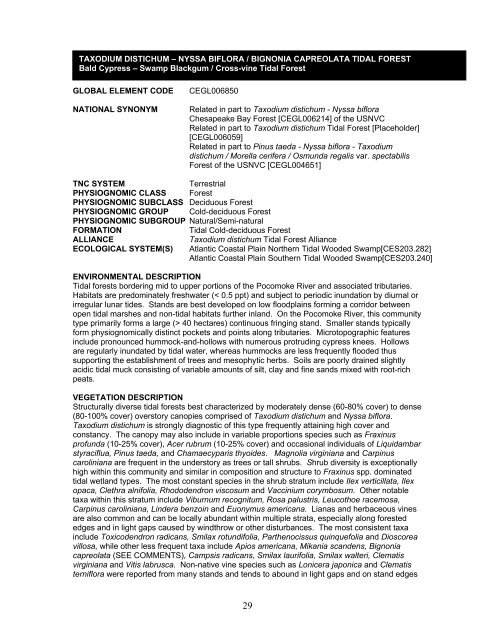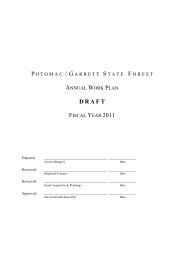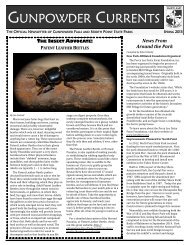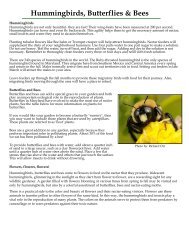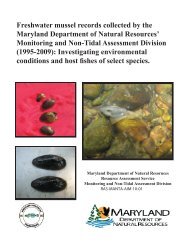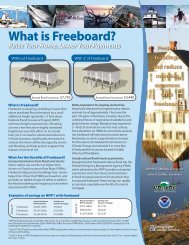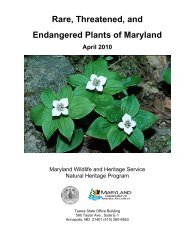tidal hardwood swamps - Maryland Department of Natural Resources
tidal hardwood swamps - Maryland Department of Natural Resources
tidal hardwood swamps - Maryland Department of Natural Resources
You also want an ePaper? Increase the reach of your titles
YUMPU automatically turns print PDFs into web optimized ePapers that Google loves.
TAXODIUM DISTICHUM – NYSSA BIFLORA / BIGNONIA CAPREOLATA TIDAL FOREST<br />
Bald Cypress – Swamp Blackgum / Cross-vine Tidal Forest<br />
GLOBAL ELEMENT CODE CEGL006850<br />
NATIONAL SYNONYM Related in part to Taxodium distichum - Nyssa biflora<br />
Chesapeake Bay Forest [CEGL006214] <strong>of</strong> the USNVC<br />
Related in part to Taxodium distichum Tidal Forest [Placeholder]<br />
[CEGL006059]<br />
Related in part to Pinus taeda - Nyssa biflora - Taxodium<br />
distichum / Morella cerifera / Osmunda regalis var. spectabilis<br />
Forest <strong>of</strong> the USNVC [CEGL004651]<br />
TNC SYSTEM Terrestrial<br />
PHYSIOGNOMIC CLASS Forest<br />
PHYSIOGNOMIC SUBCLASS Deciduous Forest<br />
PHYSIOGNOMIC GROUP Cold-deciduous Forest<br />
PHYSIOGNOMIC SUBGROUP <strong>Natural</strong>/Semi-natural<br />
FORMATION Tidal Cold-deciduous Forest<br />
ALLIANCE Taxodium distichum Tidal Forest Alliance<br />
ECOLOGICAL SYSTEM(S) Atlantic Coastal Plain Northern Tidal Wooded Swamp[CES203.282]<br />
Atlantic Coastal Plain Southern Tidal Wooded Swamp[CES203.240]<br />
ENVIRONMENTAL DESCRIPTION<br />
Tidal forests bordering mid to upper portions <strong>of</strong> the Pocomoke River and associated tributaries.<br />
Habitats are predominately freshwater (< 0.5 ppt) and subject to periodic inundation by diurnal or<br />
irregular lunar tides. Stands are best developed on low floodplains forming a corridor between<br />
open <strong>tidal</strong> marshes and non-<strong>tidal</strong> habitats further inland. On the Pocomoke River, this community<br />
type primarily forms a large (> 40 hectares) continuous fringing stand. Smaller stands typically<br />
form physiognomically distinct pockets and points along tributaries. Microtopographic features<br />
include pronounced hummock-and-hollows with numerous protruding cypress knees. Hollows<br />
are regularly inundated by <strong>tidal</strong> water, whereas hummocks are less frequently flooded thus<br />
supporting the establishment <strong>of</strong> trees and mesophytic herbs. Soils are poorly drained slightly<br />
acidic <strong>tidal</strong> muck consisting <strong>of</strong> variable amounts <strong>of</strong> silt, clay and fine sands mixed with root-rich<br />
peats.<br />
VEGETATION DESCRIPTION<br />
Structurally diverse <strong>tidal</strong> forests best characterized by moderately dense (60-80% cover) to dense<br />
(80-100% cover) overstory canopies comprised <strong>of</strong> Taxodium distichum and Nyssa biflora.<br />
Taxodium distichum is strongly diagnostic <strong>of</strong> this type frequently attaining high cover and<br />
constancy. The canopy may also include in variable proportions species such as Fraxinus<br />
pr<strong>of</strong>unda (10-25% cover), Acer rubrum (10-25% cover) and occasional individuals <strong>of</strong> Liquidambar<br />
styraciflua, Pinus taeda, and Chamaecyparis thyoides. Magnolia virginiana and Carpinus<br />
caroliniana are frequent in the understory as trees or tall shrubs. Shrub diversity is exceptionally<br />
high within this community and similar in composition and structure to Fraxinus spp. dominated<br />
<strong>tidal</strong> wetland types. The most constant species in the shrub stratum include Ilex verticillata, Ilex<br />
opaca, Clethra alnifolia, Rhododendron viscosum and Vaccinium corymbosum. Other notable<br />
taxa within this stratum include Viburnum recognitum, Rosa palustris, Leucothoe racemosa,<br />
Carpinus caroliniana, Lindera benzoin and Euonymus americana. Lianas and herbaceous vines<br />
are also common and can be locally abundant within multiple strata, especially along forested<br />
edges and in light gaps caused by windthrow or other disturbances. The most consistent taxa<br />
include Toxicodendron radicans, Smilax rotundifolia, Parthenocissus quinquefolia and Dioscorea<br />
villosa, while other less frequent taxa include Apios americana, Mikania scandens, Bignonia<br />
capreolata (SEE COMMENTS), Campsis radicans, Smilax laurifolia, Smilax walteri, Clematis<br />
virginiana and Vitis labrusca. Non-native vine species such as Lonicera japonica and Clematis<br />
terniflora were reported from many stands and tends to abound in light gaps and on stand edges<br />
29


